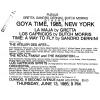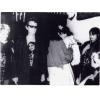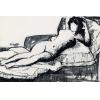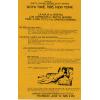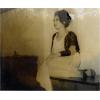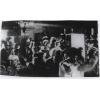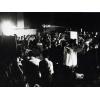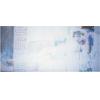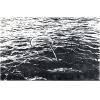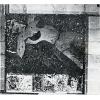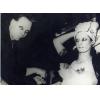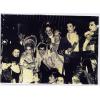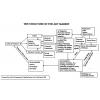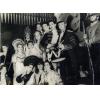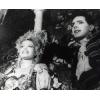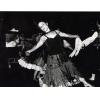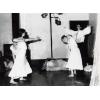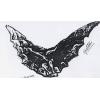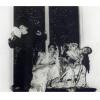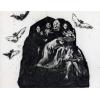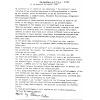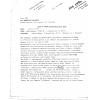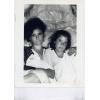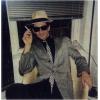On June 13 of 1985, in the gym and in the chapel of CUANDO, it was staged the first Plexus Art Opera Goya Time, 1985, New York. It was presented as a multi artforms event, made by three collaborative pieces: La Maja by Gretta Safarty; Los Capricios by Butch Morris and Time a Way to Fly by Sandro Dernini. More than 80 artists participated, among them there were musicians, poets, singers, dancers, actors and visual artists. The art opera was a compression of actions, historical references, metaphors, symbols and people. The script of this artopera was dedicated by Sandro Dernini to the TimeArt concept of Ralston Farina, who died in Berkeley few months before. TimeArt was about to escape through art from gravity and time. It was performed as an art opera play with the libretto written by Sandro Dernini, acting as artistic director, and the music score written by Butch Morris, the maestro conducting an 11 pieces orchestra, placed at the center of the gym where it took place the theatrical play, with all audience moving around freely.
Dancer /choreographer Gloria Mc Lean performed with her dance company LifeDance on the theme of Los Capricios by Goya, while a theatrical group, directed by Rajaa Fischer, made by Lynne Kanter, Antonia Iacchia, Karen Kuykendall, Melva Max, Michael Mayers and others, performed the Spanish Royal Family, representing the contemporary New York ArtWorld, dressed with XVII century’s costumes, rented from the Costume Collection of the New York Opera House. At the center of the gym, it was created an atelier des art in progress made by Pedro Cano, Franco Ciarlo, Baldo Deodato, Michael Keane, Anne Jepsen, Julius Klein, Jrelle Kraus, Raken Leaves, Judy Levy, Joe Lewis, Mike Lewis, Luca Pizzorno, Jill Lynne, Mekki Schmidt, Berns Naber, Vernita Nemec, Robert Parker, Barnaby Ruhe, Eve Vaterlaus, Robert Younger, working on the same la Maja theme, while on the stage Gretta la Maja was posing as the model.
At the same time, images of the most famous historical paintings of reclined nudeswere projected on the walls of the gym.
In the atelier, artists showed to the Royal ArtWorld Family their free interpretations of the reclined nude of the Goya’s painting La Maja against the imposition to follow one single style, imposed by the dominant art trend.
It was performed as a statement of freedom of expression in art by raising the challenging question about who in the 1995 New York ArtWorld was the subject and who was the object: The artwork or artist?
The image of Eighth of May, the famous Goya’s painting was projected on stage when the Royal ArtWorld Family performed the act of killing all artist of the atelier des arts. At the same time was projected an art market structure diagram made by the economist Cristobal Senior.
From “Time: a Way to Fly” by Sandro Dernini, New York 1985, dedicated to Ralston Farina:
With its “Ages”, “Schools” and “Isms”, the official history of criticism is not the measure of art. In this Plexus Art Opera, Goya, Breton and the eclectic New York City together are putting their fingers on the very important issue to not represent the image of reality only by the way that it appears to our human eyes.
Art like time and space can be concise as a continuum, never consumed, only imperfectly divided and represented.
Space has four dimensions and time is the Einstein’s fourth dimension. One nanosecond is a billion of fractions of a second.
It is the time with which today are operating our computers. .
It is a time that exists before to think it. It destroys the Cartesian rationality of “cogito ergo sum” I think therefore I exist.
The artist can flies through time and space with the non-rational speed of art. Art is the timer of the environmental radar of our unknown body-machine to fly out the limit of our rational worlds and markets.
Art is made in time and space by the labour of the artist.
The artist in the first person as an independent art producer can fly outside the production orders of the art market, where there is not the necessary freedom for art and artists to research and to evolve.
From “Compressionisme” by Leonard Horowitz, New York 1988:
I first experienced ‘compressionisme’ in the Spring of 1985, where I was suddenly engulfed by a “Total Theatre” environmental spectacular Opera called “Goya Time,” a continuous and extremely compressed dramatization of three paintings by Francisco Goya: “The Nude Maja,” “The Royal Family,” and “The Eight of May.” This avant garde “Co-opera” was conceived, produced and directed by Dr. Sandro Dernini, an accomplished biologist from the island of Sardinia, in collaboration with Gretta Safarty and Lawrence “Butch” Morris. By dramatizing these three Goya painting and having this cast of Goya costumed artists literally run through the audience, it destroyed the normal sense of separation of staged theatre, since all at once you were not only the observer, but a participant.
In order to really catch the total and unexpected actions taking place, one had to constantly shift one’s view from the Royal family on the balcony and further physically follow their descent through the amazed milling crowd below. The Royal Family pushed their way through the packed gymnasium, past thirty artists doing their simultaneous versions of the Nude Maja, and brushed past me, almost knocking me down. The whole spectacle was tied together and totally reified by modular music created and conducted and orchestrated by Butch Morris and further amplified by the dancing of Gloria McLean and company.
The whole Opera lasted an hour chronologically .... but... psychologically seemed to be over in ten minutes. So we can say that because of the concept and the simulsensuous presentation, that there was an intense compression of time, of events, of experience, of total unexpectedness.
If one agrees with the theory that art should contain elements of surprise, then this plexus process and operas by Robert Wilson, by Meredith Monk and the Ontological-Hysterical process of Richard Forman is that Robert Wilson, Meredith Monk and Richard Forman tend to suspend time, to Surrealize it, and certainly in Robert Wilson work, to stretch time into a suspended “Dream State,” a psychedelicate state. If we have been subconsciously influenced by the motion picture (and now television), as I believe we all are, then the obvious differences between the plexus process and especially any of Wilsons masterpieces (Einstein on the Beach) is that Robert Wilsons ouvre has a strong sense of slowed motion and Plexus has the quality of Pixillation, of jump cut, of extreme compression.
A Polish mathematician, Klaus Wyborny, working in Hamburg, Germany, a number of years ago (and using a timing devise on his camera), automatically pixillated frames from Citizen Kane and compressed this famous film into three minutes!
The result is a very short film that compresses the images to the extent that the people disappear and the images are transformed into an atomic type mushroom cloud with a peculiar black dot that seems like an insect flying in and out of the cloud. This is a transformation of the original classic into a totally abstract process and sculptural vision. And that has been the Plexus Process, whether we have dealt with the theme of Dante’s Purgatorio, with the symbolic universal Serpent and with Eve in the Garden of Eden. The very idea of “Modern Art” has to do with this ‘compressionistic’ process, since time certainly speeded up psychologically and physically for the French Impressionists, who invented modern art by: Improvising, by having a speeded-up moment to moment interaction with the last brush stroke and with the reified overall effect. They did it to the extent that the real subject matter of all modern art becomes the process itself, and any visual subject matter really becomes a vehicle employed in this amazing compressionistic process. (The tail wags the dog). No painter who has been sensitive and aware of “Whats been going on” has failed to be positively influenced by this direct improvised process. If we draw a line from the cubist space of Cezanne, we can extend this modern compass through Picasso and into the New York School of “Action-Painting,” the so called Abstract Expressionism, especially early DeKooning. We can draw another line from Gaugin through Matisse and into Color Field painting, into more interactive color-shapes in space. This flattening out of the picture plane not only compresses space, but... returns it to a universal ‘primitive’ sense as envisioned by Gaugin and even Mark Rothko.
(if you have a guest and a host, then you have a GHOST... Marcel Duchamp)


